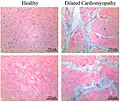Fibrosis: Difference between revisions
No edit summary |
CSV import |
||
| Line 89: | Line 89: | ||
[[Category:Medical terminology]] | [[Category:Medical terminology]] | ||
[[Category:Rheumatology]] | [[Category:Rheumatology]] | ||
<gallery> | |||
File:Cirrhosis_high_mag.jpg|Cirrhosis at high magnification | |||
File:Bridging_fibrosis_in_rat_liver_exposed_to_thioacetamide.jpg|Bridging fibrosis in rat liver exposed to thioacetamide | |||
File:Histopathology_of_interstitial_fibrosis_in_dilated_cardiomyopathy.jpg|Histopathology of interstitial fibrosis in dilated cardiomyopathy | |||
File:Histopathology_of_dense_fibrous_scar_replacing_myocyte_loss_in_myocardial_infarction.jpg|Histopathology of dense fibrous scar replacing myocyte loss in myocardial infarction | |||
</gallery> | |||
Revision as of 05:04, 18 February 2025
| Fibrosis | |
|---|---|

| |
| Synonyms | |
| Pronounce | |
| Field | Pathology, rheumatology |
| Symptoms | Often asymptomatic; can vary based on the affected organ |
| Complications | Cirrhosis, organ dysfunction, loss of organ function |
| Onset | Can be congenital or acquired |
| Duration | Chronic or progressive |
| Types | Depending on the affected tissue or organ |
| Causes | Chronic inflammation, repeated injury, genetic predispositions |
| Risks | Chronic diseases, radiation exposure, certain medications, environmental toxins |
| Diagnosis | Biopsy, imaging techniques, laboratory tests |
| Differential diagnosis | Other conditions causing organ dysfunction or scarring |
| Prevention | Control of inflammation, avoidance of causative agents, genetic counseling |
| Treatment | Depends on cause and location; may include medications, therapy, or surgery |
| Medication | Anti-inflammatory drugs, antifibrotic agents, enzyme replacements |
| Prognosis | Varies; can be benign or lead to severe organ dysfunction |
| Frequency | Varies based on type and cause |
| Deaths | Depends on severity and organ involvement |
Fibrosis is the pathological accumulation of excess fibrous connective tissue in organs or tissues as a reparative or reactive process.<ref>Birbrair, Alexander,
Type-1 pericytes accumulate after tissue injury and produce collagen in an organ-dependent manner, Stem Cell Research & Therapy, Vol. 5(Issue: 6), pp. 122, DOI: 10.1186/scrt512, PMID: 25376879, PMC: 4445991,</ref> While it can be a reactive or benign state, pathological fibrosis can severely compromise the function of the affected organ. The process may be termed scarring when it follows injury. Fibrosis that arises from a single cell line is labeled a fibroma. Essential to the wound healing process, fibrosis can nevertheless disrupt the normal architecture and function of the underlying organ or tissue when excessive.<ref>Glossary of dermatopathological terms. DermNet NZ</ref> Predominantly characterized by the excessive accumulation of extracellular matrix (ECM) proteins, fibrosis essentially represents an overzealous wound healing response that can significantly hinder normal organ function.<ref name="pmid26435749">, Epigenetics and the overhealing wound: the role of DNA methylation in fibrosis, Fibrogenesis & Tissue Repair, Vol. 8, pp. 18, DOI: 10.1186/s13069-015-0035-8, PMID: 26435749, PMC: 4591063,</ref>
Physiology
The physiological mechanisms underlying fibrosis bear a close resemblance to those of scarring; both processes involve the deposition of connective tissue by stimulated fibroblasts. Initiating factors often include soluble substances released by immune cells, such as macrophages. TGF beta, the most extensively studied pro-fibrotic mediator, is secreted by macrophages and the interstitium in damaged tissues. Other key soluble fibrosis mediators encompass CTGF, platelet-derived growth factor (PDGF), and interleukin 10 (IL-10). These molecules activate intricate signal transduction pathways, notably the AKT/mTOR<ref>,
Dual mTOR Inhibition Is Required to Prevent TGF-β-Mediated Fibrosis: Implications for Scleroderma., J Invest Dermatol, 2015, Vol. 135(Issue: 11), pp. 2873–6, DOI: 10.1038/jid.2015.252, PMID: 26134944, PMC: 4640976,</ref> and SMAD<ref>, TGF-beta signaling and the fibrotic response, FASEB Journal, 2004, Vol. 18(Issue: 7), pp. 816–827, DOI: 10.1096/fj.03-1273rev, PMID: 15117886,</ref> pathways, which stimulate fibroblast proliferation and activation, ultimately leading to the deposition of extracellular matrix in the surrounding connective tissue. Although vital for tissue repair, if this process becomes deregulated or encounters repetitive or severe tissue injuries, it can culminate in a progressive, irreversible fibrotic response.<ref name="pmid26435749"/>
Anatomical location
Fibrosis manifests in multiple body tissues, often as a result of damage or inflammation. The following are common examples:
Lungs
Liver
Heart
- Atrial fibrosis
- Endomyocardial fibrosis
- Post-myocardial infarction fibrosis
Brain
Other Tissues and Organs
Incidence
Recent studies have highlighted the increasing incidence of fibrosis in various conditions. For instance, liver fibrosis due to chronic hepatitis C infection has emerged as a significant healthcare issue in several countries.<ref>,
The natural history of hepatitis C, Semin Liver Dis, 2004, Vol. 24(Issue: Suppl 2), pp. 3–8, DOI: 10.1055/s-2004-832922, PMID: 15349804,</ref> Also, idiopathic pulmonary fibrosis has observed an uptick in incidence in the last two decades, making it a research priority in respiratory medicine.<ref>, Incidence and prevalence of idiopathic pulmonary fibrosis in US adults 18-64 years old, Eur Respir J, 2015, Vol. 46(Issue: 2), pp. 473–8, DOI: 10.1183/09031936.00184114, PMID: 26022957,</ref>
See also
Fibroblast Granuloma Interstitial lung disease Scarring
|
|
|
| Wound healing |
|---|
|
|
| Connective tissue | ||||||
|---|---|---|---|---|---|---|
|
-
Cirrhosis at high magnification
-
Bridging fibrosis in rat liver exposed to thioacetamide
-
Histopathology of interstitial fibrosis in dilated cardiomyopathy
-
Histopathology of dense fibrous scar replacing myocyte loss in myocardial infarction






